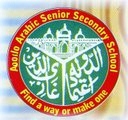Anglo Arabic Senior Secondary School
| Anglo Arabic Senior Secondary School | |
|---|---|
 | |
 School's gated main entrance | |
| Location | |
 | |
, , 110006 India | |
| Coordinates | 28°38′46″N 77°13′22″E / 28.6460°N 77.2229°E |
| Information | |
| Other name | Anglo Arabic School, Delhi |
| Former name | Madrasa Ghaziuddin Khan |
| Funding type | State school |
| Motto | Find a Way or Make One |
| Religious affiliation(s) | Islam |
| Established | 1949 |
| Founder | Ghazi ud-Din Khan Feroze Jung I |
| Status | Operating |
| Educational authority | Central Board of Secondary Education |
| School number | 2778035[2] |
| School code | 01228 |
| Principal/Chairman | Mohd Wasim Ahmed[3] |
| Head teacher | Shabab Haider |
| Faculty | 89 |
| Grades | 6th through 12th |
| Gender | Coeducational |
| Age | 10 to 17 |
| Enrollment | > 2,000 |
| Language | |
| Hours in school day | 6.5 (07:45–14:15) |
| Campus type | Urban |
| Colour(s) | Red, White and Grey |
| Sports | |
| Team name | Anglo-Arabic |
| Website | angloarabic |
The Anglo Arabic Senior Secondary School or more commonly, Anglo Arabic School, is a co-educational government aided school[4] in New Delhi, India. The school is managed by Delhi Education Society. Talat Ahmed is the president of the School Managing Committee. It was founded in 1696 by Ghazi ud-Din Khan Feroze Jung I.[5]
History

It was initially founded by Ghaziuddin Khan, a general of Mughal Emperor Aurangzeb, a leading Deccan commander and the father of Qamar-ud-din Khan, Asaf Jah I, the founder of the Asaf Jahi dynasty of Hyderabad, also known as the first Nizam of Hyderabad, in 1690s, and was originally termed Madrasa Ghaziuddin Khan after him. However, with a weakening Mughal Empire, the Madrasa closed in the early 1790s, but with the support of local nobility, an oriental college for literature, science and art, was established at the site in 1792.
It stood just outside the walled city of Delhi outside the Ajmeri Gate, close to the New Delhi Railway Station. It was originally surrounded by a wall and connected to the walled city fortifications and was referred to as the College Bastion.
It was reorganized as the 'Anglo Arabic College' by the British East India Company in 1828 to provide, in addition to its original objectives, an education in English language and literature. The object was "to uplift" what the Company saw as the "uneducated and half-barbarous people of India." Behind the move was Charles Trevelyan, the brother-in-law of Thomas Babingdon Macaulay, the same Macaulay whose famously declared that "a single shelf of a good European library was worth the whole native literature of India and Arabia".
Dr. Sprenger, then principal, presided over the founding of the college press, the Matba‘u ’l-‘Ulum and founded the first college periodical, the weekly Qiranu ’s-Sa‘dain, in 1845.
Notable alumni
- Syed Ahmed Khan, founder of Aligarh Muslim University
- Liaqat Ali Khan, Pakistan's first Prime Minister
- Muhammad Husain Azad, writer
- Habib Jalib
- Nazir Ahmed, essayist
- Akhtar-ul-Iman, poet
- Mirza MN Masood, hockey
Olympian[6]
See also
- Zakir Husain Delhi College, another descendant of the original institution
References
- ^ Alam, Aftab (June 2012). An Ethnographic Study of Anglo-Arabic School, Delhi (PDF) (Doctor of Philosophy thesis). New Delhi: Jamia Millia Islamia.
- ^ "School Directory - Complete Information Form". Central Board of Secondary Education. 1 April 2008. Archived from the original on 24 September 2019. Retrieved 24 September 2019.
- ^ "Particulars of School Management Commitee [sic] Report". Directorate of Education - Government of NCT of Delhi. Retrieved 24 September 2019.
- ^ "Court notice over girls' admission to Delhi school". The Times of India. Retrieved 7 June 2012.
- ^ Firoz Bakht, Ahmed. "Anglo Arabic School: a three-century old academic". The Milli Gazette. Retrieved 4 August 2011.
{{cite web}}: CS1 maint: url-status (link) - ^ "Learning seat still survives". Deccan Herald. 8 August 2009. Retrieved 4 August 2011.
{{cite web}}: CS1 maint: url-status (link)
